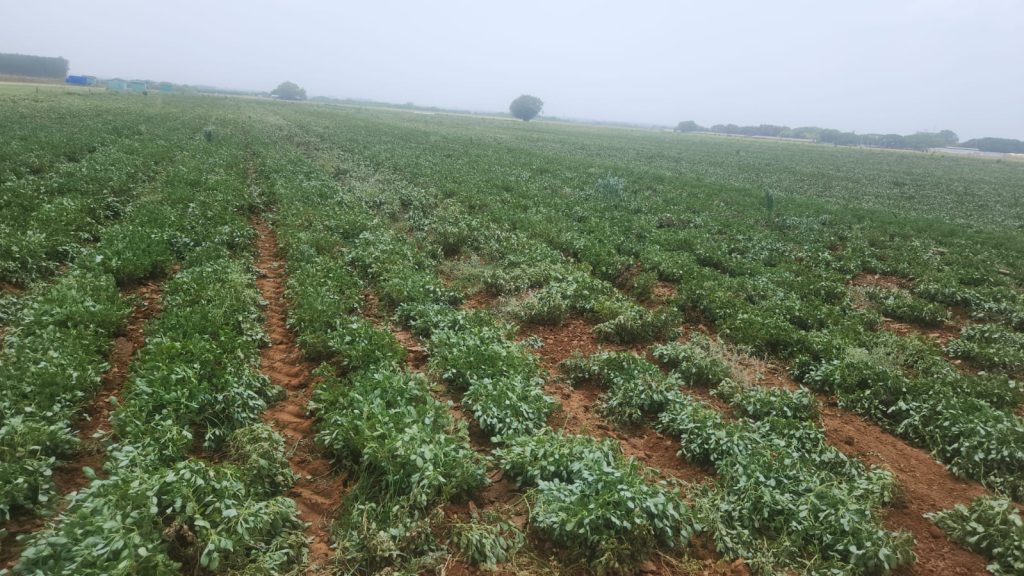Weed Management in Groundnut Farming

This post is also available in:
This post is also available in:
![]() हिन्दी (Hindi)
हिन्दी (Hindi)
Weed management is important for groundnut farming to ensure optimal crop growth and yield. Weeds compete with groundnut plants for essential resources like nutrients, water, and sunlight, reducing yields and quality.
The major weeds in Groundnut farming are:
- Amaranthus viridis
- Boerhaavia diffusa
- Celosia argentena
- Chloris barbata
- Cynodon dactylon
- Cyperus rotundus
- Portulaca oleracea
- Trichodesma indicum
- Parthenium hysterophorus
Here are some weed management practices commonly employed in groundnut farming:
- Tillage: Proper tillage techniques, such as plowing or harrowing, can help control weeds by burying weed seeds deeper into the soil, preventing their germination. However, excessive tillage should be avoided as it can disrupt the soil structure and increase erosion risks.
- Crop rotation: Practicing crop rotation helps break the weed cycle, as different crops have varying growth habits and weed susceptibilities. Alternating groundnut cultivation with other crops can disrupt weed populations.
- Mulching: Mulching is a method where organic or synthetic materials are placed on the soil surface around the groundnut plants. This helps suppress weed growth by blocking sunlight and inhibiting weed seed germination. Organic mulches like straw, leaves, or grass clippings can also provide additional nutrients as they decompose. Applying surface mulches like organic residues or polythene mulch also helps reduce the weed population in groundnut fields (Devi Dayal et al., 1994).
- Hand weeding: Manual removal of weeds by hand is a labor-intensive but effective method, especially during the early stages of groundnut growth. Hand weeding allows targeted removal of weeds without damaging the groundnut plants. Generally, two to three-hand weeding is recommended at 25, 35, and 45 days after sowing (DAS).
- Herbicides: Herbicides can be used to control weeds in groundnut farming. Choosing the right herbicide based on the weed species and growth stage is essential, following label instructions and safety precautions. Pre-emergence herbicides are applied before groundnut emergence, while post-emergence herbicides target already emerged weeds.
For rainfed groundnut cultivation, Fluchloralin @2.0 l/ha can be applied at Pre-emergence soil incorporation and Pendimethalin @ 1.0-1.5 kg a.i./ha at pre-emergence application. At post-emergence at 25-30 DAS stage, Imazethapyr @ 0.075 kg a.i./ha or Fluazifop-p-butyl @ 0.25 kg a.i./ha or Quizalofop-ethyl @ 0.05 kg a.i./ha is recommended. 
Some of the precautions to be taken during the application of herbicides:
- Use only the recommended herbicide, dose, and time of application.
- Spray when the wind velocity is low and take into account the direction of the wind while spraying when susceptible crops are nearby.
- Keep the livestock away from sprayed crops.
- The solution should not come in contact with the body as most of them cause irritation to the skin.
- Spray in sunny weather to have effective control.
- Do not use the same equipment for insecticides and fungicides if 2,4-D is sprayed with it.
- There should be sufficient soil moisture for the effectiveness of weedicides/herbicides.
- Prepare the herbicidal solution in a glass or enamel container.
- Maintain uniform pressure for uniform spray.
Integrated weed management in groundnut
Combining multiple weed control methods is often the most effective approach. Integrated weed management includes a combination of cultural practices (crop rotation, tillage), physical methods (mulching, hand weeding), and chemical methods (herbicides) to reduce weed pressure and minimize herbicide use. Several other reports have also confirmed that weed control efficiency and net return increase significantly when chemical control measures are combined with mechanical and hand-weeding measures (Belorkar et al., 1995; Murthy et al., 1994; Panwar et al., 1988).
One should need to consider local regulations, label instructions, and best agricultural practices when implementing weed management strategies. It is also beneficial to consult with local agricultural extension services or agronomists for personalized advice based on specific farming conditions.
Reference:
- http://agritech.tnau.ac.in/agriculture/agri_weedmgt_groundnut.html
- Belorkar, V. T., Chaudhary, B. T., Khakhre, M. S. and Deshmukh, R. G. (1995). Relative efficiency and economics of cultural, chemical and integrated methods of weed control in groundnut. P. K. V. Res. J., 19: 67-68.
- Devi Dayal, Naik, P. R., Dongre, B. N. and Reddy, P. S. (1994). Effect of row pattern and weed control method on yield and economics of rainfed groundnut. Indian J. Agric. Sci., 446-449.
- Murthy, B. G., Agasimani, C. A., Babalad, H. B. and Pratibha, N. C. (1994). Studies on integrated weed control in kharif groiundnut. Farming System, 10: 66-69.
- S.N.Nigam, 2015. Groundnut at a glance.
- Panwar, R. S., Malik, R. K. and Bhan, V. N. (1988). Chemical weed control in groundnut. Indian J. Agron., 33: 458- 459.
Further reading
Groundnut: Plant Information, History, Uses and Nutrition Value
Principles of selecting the best varieties of Groundnut: A Comprehensive Guide
Groundnut Soil requirement, Soil preparation and Planting
Weed Management in Groundnut Farming
Fertilizer requirement for Groundnut Cultivation
Irrigation Requirement and Methods for Groundnut Cultivation
Groundnut Diseases and Management Practices









































































